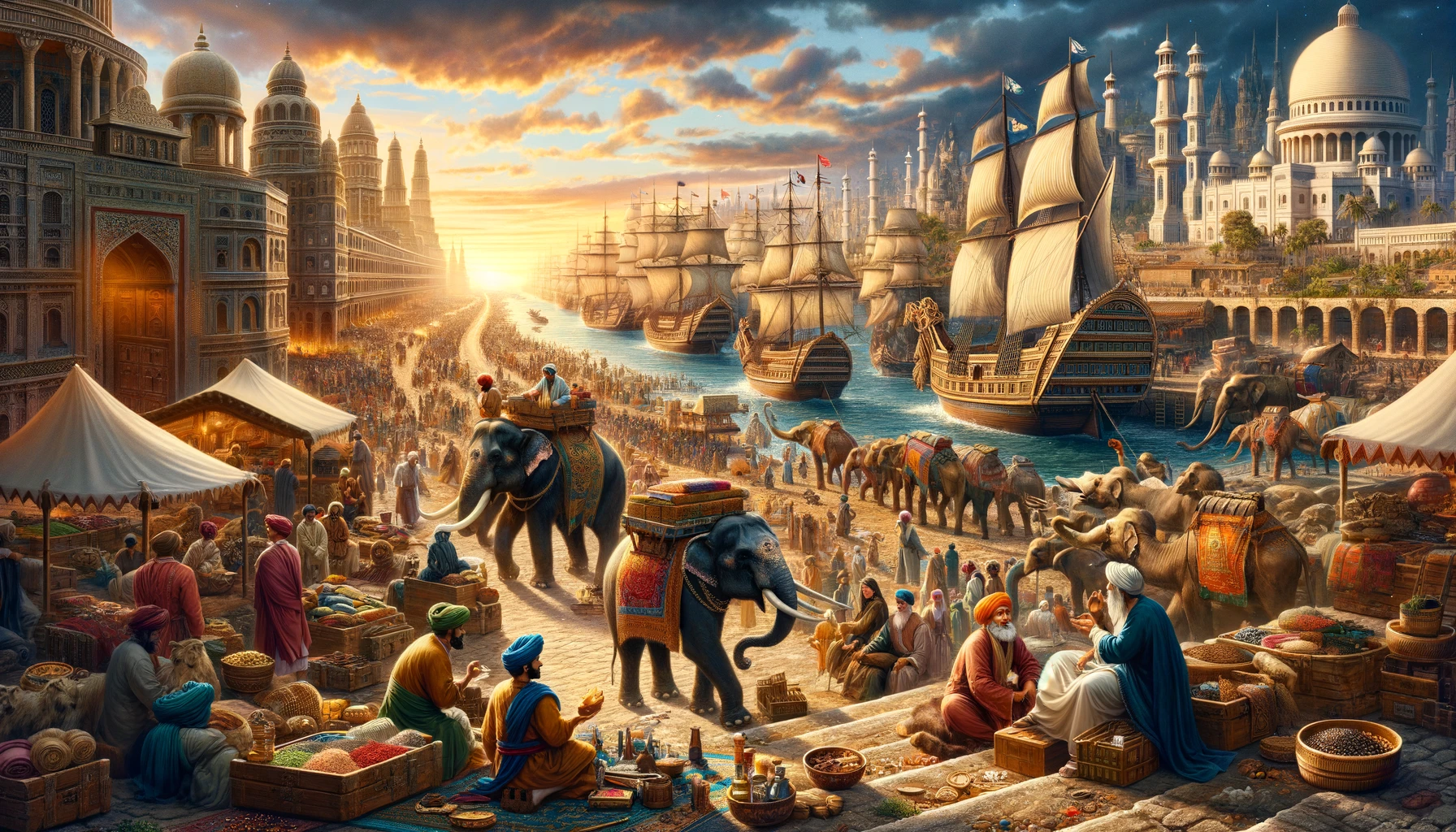The ancient world was interconnected by a vast network of trade routes that facilitated the exchange of goods, ideas, and cultures. In a recent webinar, “Unveiling ‘The Golden Road’: The Ancient Trade Route That Shaped Our World” with William Dalrymple, viewers are taken on a captivating journey through time to explore one of the most significant trade routes in history.
This presentation shed light on the profound impact of ‘The Golden Road’ on the civilisations of India, China, and Rome, offering valuable insights into the dynamics of ancient commerce and cultural exchange. This post delves into the rich tapestry of history woven by these ancient trade routes, uncovering the stories of merchants, sailors, and scholars who shaped our world centuries ago.
India’s Crucial Historical Role
India holds a pivotal place in the annals of history, yet its significance as an economic and civilisational hub often remains overshadowed. In “The Golden Road,” an upcoming book by William Dalrymple, India’s historical prominence takes centre stage. The book aims to shed light on India’s often overlooked position in ancient and early medieval Eurasian history, highlighting its role as a crucial nexus of trade and culture.
Throughout the ages, India served as a vibrant centre of commerce and exchange, connecting diverse regions across the globe. Its strategic location at the crossroads of trade routes facilitated the movement of goods, ideas, and people, enriching both its own society and those with which it interacted.
Despite its significance, India’s role has been somewhat overshadowed in historical narratives, with emphasis often placed on other regions such as Rome and China. However, “The Golden Road” seeks to rectify this oversight by showcasing India’s contributions to global trade networks and its profound cultural influence on the wider world.
By exploring India’s pivotal role in shaping ancient trade routes and fostering intellectual exchange, “The Golden Road” promises to provide a fresh perspective on the historical narrative, offering insights into the rich tapestry of India’s past and its enduring impact on the course of history.
Challenging Historical Perceptions
Contrary to popular belief, historical records suggest that direct contact between Rome and China was limited, with India emerging as a key intermediary in the exchange of goods and ideas. While the concept of the Silk Road dominates discussions of ancient trade routes, “The Golden Road” presents a compelling argument for the significance of India’s maritime trade routes, particularly through the Red Sea.
These trade routes, facilitated by India’s access to the sea, allowed for direct commerce between Rome and the Indian subcontinent. This direct link enabled the flow of commodities such as spices, textiles, and precious metals, enriching both Roman and Indian societies.
The recent inauguration of the India-Middle East economic corridor, following the historical trade routes outlined in “The Golden Road,” serves as a testament to the enduring legacy of ancient trade networks. This corridor not only fosters economic cooperation but also highlights the historical continuity of trade connections that have shaped the region for millennia.
Cultural Exchange Through Trade
“The Golden Road” illuminates the profound cultural exchange that occurred through ancient trade networks, particularly the maritime routes connecting India with the rest of the world. While the Silk Road is often romanticised as the primary conduit for East-West interaction, India’s sea routes played an equally significant role in facilitating the exchange of goods, ideas, and cultures.
One of the key aspects highlighted in the book is the transmission of Indian mathematical and numerical concepts to the Western world. Concepts such as zero and the decimal system, originating in ancient India, were transmitted westwards through trade routes, profoundly influencing mathematics, astronomy, and astrology in Europe and the Middle East.
This cultural exchange was not limited to intellectual concepts but also encompassed art, religion, and philosophy. Indian art and architectural styles, including those of Buddhist stupas and Hindu temples, found their way to distant lands such as Southeast Asia and China, leaving an indelible mark on the artistic heritage of these regions.
Moreover, the influx of Indian goods such as spices, textiles, and precious stones into the Roman Empire and beyond sparked a fascination with Indian culture and spurred further interaction between East and West. This cross-cultural exchange fostered a rich tapestry of diversity and innovation, shaping the identities of societies along ancient trade routes.
India’s Contemporary Influence
Beyond its historical significance, India continues to exert a profound influence on the global stage, particularly in the realms of technology, economics, and innovation. “The Golden Road” prompts us to consider India’s trajectory from a historical trading powerhouse to a modern-day economic powerhouse, poised to become one of the world’s leading economies.
In the contemporary era, India’s technical prowess is evident in its prominent presence in the global tech industry. Indian professionals occupy key positions in major companies such as Microsoft, Apple, and Google, contributing to groundbreaking advancements in technology and innovation. The concentration of Indian talent in Silicon Valley and other tech hubs underscores India’s status as a breeding ground for technological innovation.
Moreover, India’s economic ascent is undeniable, with the nation surpassing Britain to become the fifth-largest economy in the world. With projections indicating further growth, India is poised to overtake Japan and Germany to claim the third spot, cementing its position as a global economic powerhouse.
This rapid economic growth is underpinned by India’s robust education system, particularly institutions such as the Indian Institutes of Technology (IITs), which churn out highly skilled graduates capable of competing on the global stage. The legacy of ancient Indian scholarship continues to resonate in the modern era, with India’s intellectual capital driving innovation and progress across diverse fields.
India-China Relations: Past, Present & Future
In the context of contemporary geopolitics, the relationship between India and China has emerged as a focal point of global interest. While historical narratives often highlight India’s role as a bridge between East and West, “The Golden Road” prompts us to consider the complexities of India-China relations throughout history and into the modern era.
Historically, India and China maintained extensive trade and cultural exchanges along ancient trade routes, facilitated by their geographical proximity and shared interests. However, as “The Golden Road” elucidates, these interactions were not without tensions and conflicts, reflecting the complexities of interstate relations in the ancient world.
In the modern era, India and China find themselves at the forefront of global economic and geopolitical dynamics, with their respective rise as economic powerhouses reshaping the global order. The Belt and Road Initiative (BRI) proposed by China and India’s growing economic influence underscore the strategic significance of their relationship in shaping the future of Asia and beyond.
Despite economic cooperation and cultural exchange, India and China also grapple with longstanding territorial disputes and geopolitical rivalries, which have at times strained their bilateral relations. “The Golden Road” prompts us to consider the historical context of these tensions and the implications for contemporary geopolitics.
Looking to the future, “The Golden Road” encourages dialogue and cooperation between India and China to address shared challenges and opportunities. As both nations navigate the complexities of the modern world, understanding their historical ties and shared heritage can serve as a foundation for building mutual understanding and cooperation in the pursuit of peace and prosperity.
The Complexity of Ancient India
Ancient India presents a fascinating tapestry of cultural diversity and historical complexity, characterised by a rich exchange of ideas and goods without the imposition of political dominance. Unlike China, which often exhibited a centralized political structure, ancient India was marked by a fragmented political landscape comprising numerous kingdoms and empires.
While India’s political fragmentation may seem like a disadvantage in comparison to China’s centralized authority, it actually fostered a dynamic environment conducive to cultural exchange and innovation. The absence of a single overarching political authority allowed for the flourishing of diverse religious, philosophical, and artistic traditions across different regions of the subcontinent.
India’s cultural influence transcended its political boundaries, spreading its philosophical and religious ideas, architectural styles, and artistic motifs across Southeast Asia, Central Asia, and beyond. Buddhist missionaries, Hindu traders, and scholars traversed ancient trade routes, carrying with them not only goods but also the seeds of Indian civilization.
In contrast, China’s centralized political structure under imperial dynasties facilitated uniformity and stability within its borders but limited the scope for cultural diversity and innovation. While China’s emperors wielded considerable power and authority, India’s decentralized governance allowed for a more pluralistic society where different religious and philosophical traditions coexisted and interacted.
Final Thoughts
“The Golden Road” invites us to appreciate the complexity of ancient India, where cultural influence flourished alongside political fragmentation. By contrast, China’s centralized structure may have facilitated political stability but potentially stifled the diversity and dynamism inherent in India’s decentralized governance model.
“The Golden Road” offers a compelling exploration of ancient trade routes and their enduring impact on the course of history. Through the lens of India’s historical role as a nexus of trade and cultural exchange, the book unveils a rich tapestry of interconnectedness that transcended geographical boundaries and shaped the development of civilizations.
From the bustling ports of ancient India to the courts of emperors in distant lands, the echoes of trade and cultural exchange reverberate through the annals of time. “The Golden Road” reminds us of the pivotal role played by ancient trade networks in disseminating ideas, goods, and technologies across continents, laying the foundation for the interconnected world we inhabit today.
Moreover, the book prompts us to reflect on the complexities of India’s historical legacy, characterized by cultural influence without political dominance. India’s decentralized governance model fostered a dynamic environment where diverse traditions thrived and interacted, leaving an indelible imprint on the cultural landscapes of Asia and beyond.
As we contemplate the lessons of “The Golden Road,” we are reminded of the importance of understanding our shared history and embracing the diversity of human experience. By acknowledging the interconnectedness of civilizations and the enduring legacy of ancient trade routes, we gain a deeper appreciation for the complexities of our collective heritage.
In the face of contemporary challenges and opportunities, “The Golden Road” serves as a beacon of inspiration, urging us to forge new paths of cooperation and understanding in an increasingly interconnected world. Through dialogue, cooperation, and mutual respect, we can harness the lessons of the past to build a more inclusive and prosperous future for all.




